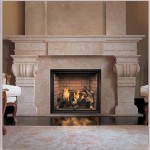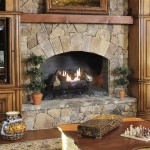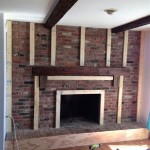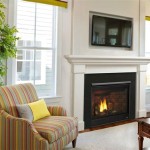Choosing the Right Mantel for Your Ventless Gas Fireplace
Ventless gas fireplaces provide a convenient and efficient heating solution for many homes. They offer the ambiance of a traditional fireplace without the need for a chimney or extensive venting system. However, the design and installation of a ventless gas fireplace require careful consideration, especially regarding the surrounding materials. One crucial element is the mantel, which serves both aesthetic and safety purposes. The selection of an appropriate mantel for a ventless gas fireplace is vital for achieving the desired look while adhering to safety regulations and manufacturer recommendations.
The primary function of a fireplace mantel is to create a focal point in the room, adding character and style to the overall décor. However, its role extends beyond aesthetics. The mantel also serves as a protective barrier, shielding combustible materials above the fireplace from excessive heat. Specifically, the mantel prevents the surface above the fireplace opening from overheating, potentially causing damage or posing a fire hazard. Therefore, selecting a mantel that is compliant with safety standards and effectively redirects heat is paramount for ventless gas fireplaces.
Ventless gas fireplaces, while convenient, do generate heat that radiates upwards. The amount of heat produced, and the distance required between the fireplace opening and combustible materials, is often stipulated by the fireplace manufacturer and local building codes. These guidelines dictate minimum clearances to ensure safe operation. Failing to adhere to these requirements can result in the voiding of warranties, potential fire hazards, and even legal repercussions.
Furthermore, the material used for the mantel plays a significant role in its effectiveness and safety. Some materials are more resistant to heat than others, making them more suitable for fireplace mantels. Understanding the properties of different materials and their suitability for use with ventless gas fireplaces is essential for making an informed decision.
Understanding Clearance Requirements
Clearance requirements are a foundational aspect of ventless gas fireplace installation. These requirements specify the minimum distances between the fireplace opening and any combustible materials, including the mantel. These distances are determined by testing and are designed to prevent the combustible materials from reaching ignition temperatures. Fireplace manufacturers typically provide detailed diagrams and instructions outlining these clearances in their installation manuals. Local building codes may also impose additional or more stringent requirements, which must also be followed.
The clearance requirements usually vary depending on the fireplace model, BTU output, and the type of combustible material in question. For instance, the required clearance for a wood mantel might be greater than that for a non-combustible material such as stone or concrete. Some manufacturers may explicitly prohibit the use of certain materials altogether, regardless of clearance. Therefore, carefully reviewing the manufacturer’s instructions and consulting with local building officials is crucial before selecting and installing a mantel.
It is important to recognize that clearance requirements are not just about the distance directly above the fireplace opening. They also extend to the sides and the depth of the mantel. Heat can radiate in multiple directions, and improper clearances on the sides or the depth of the mantel can still create a fire hazard. Therefore, a thorough understanding of the clearance envelope is essential to ensure safety.
In situations where the desired mantel design does not meet the minimum clearance requirements, there are several options. One approach is to use a non-combustible facing material, such as tile or stone, to reduce the clearance needed. Another option is to install a heat shield, which is a non-combustible barrier that deflects heat away from combustible materials. Heat shields must be properly installed and sized to be effective, and it's best to consult with a qualified professional to determine the appropriate solution for your specific installation.
Choosing the Right Mantel Material
The choice of mantel material directly influences both its aesthetic appeal and its ability to withstand the heat generated by a ventless gas fireplace. Different materials possess varying degrees of heat resistance, and each offers a unique visual character. Common mantel materials include wood, stone, concrete, and metal, each offering distinct advantages and disadvantages.
Wood is a popular choice for fireplace mantels due to its warmth, versatility, and availability. However, wood is a combustible material and therefore requires careful consideration regarding clearance requirements. Hardwoods, such as oak or maple, tend to be more heat-resistant than softwoods, such as pine. If using wood, it's crucial to ensure that it has been properly treated and seasoned to reduce the risk of warping or cracking due to heat exposure. As previously mentioned, heat shields or non-combustible facings may be necessary to mitigate the risk of fire when using a wood mantel.
Stone and concrete are excellent choices for mantels due to their inherent non-combustibility and durability. These materials are naturally resistant to heat and will not ignite, making them a safer option than wood. Stone mantels can range from rustic fieldstone to sleek marble, offering a wide range of aesthetic possibilities. Concrete mantels can be cast in various shapes and finishes, providing a contemporary and industrial look. While stone and concrete are heavier than wood, professional installation can ensure stability and proper mounting.
Metal, particularly steel, is another non-combustible option for fireplace mantels. Metal mantels offer a modern and minimalist aesthetic and can be fabricated in various designs. However, metal can conduct heat, so it is important to ensure that the mantel is properly insulated or that adequate clearances are maintained to prevent surface temperatures from becoming excessively hot. Metal mantels may also require a protective coating to prevent rust or corrosion.
In addition to the primary mantel material, consider the finish and any coatings applied to the mantel. Some finishes, such as certain paints or varnishes, may be more susceptible to heat damage than others. When choosing a finish, opt for heat-resistant options that are specifically designed for use in fireplace applications. This will help to ensure the longevity and appearance of the mantel.
Installation and Safety Considerations
Proper installation is crucial for ensuring the safe and effective operation of a ventless gas fireplace and its mantel. Incorrect installation can compromise safety, void warranties, and potentially lead to dangerous situations. Therefore, it is essential to follow the manufacturer's instructions and local building codes meticulously.
Prior to installation, thoroughly inspect the fireplace and mantel for any signs of damage or defects. Ensure that all components are in good working order and that the mantel is structurally sound. If any issues are identified, address them before proceeding with the installation.
During installation, double-check all clearance requirements and measurements. Use a measuring tape and level to ensure accurate placement and alignment. Pay particular attention to the spacing between the fireplace opening and the mantel, as well as the overall height and depth of the mantel.
When attaching the mantel to the wall, use appropriate fasteners and mounting hardware. The type of fastener required will depend on the weight of the mantel and the construction of the wall. Ensure that the fasteners are securely anchored in the wall studs or other structural members. If necessary, consult with a professional contractor or installer to determine the appropriate attachment method.
After the mantel is installed, conduct a thorough inspection to verify that it is properly secured and that all clearances are met. Check for any gaps or cracks that might allow heat to escape and potentially damage the surrounding materials. If any issues are identified, address them promptly.
Finally, it is highly recommended to install a carbon monoxide detector in the vicinity of the ventless gas fireplace. While ventless gas fireplaces are designed to burn cleanly, they can still produce carbon monoxide if not properly maintained or if the gas is not burning completely. A carbon monoxide detector will provide an early warning in the event of a carbon monoxide leak, allowing you to take corrective action and prevent potential health risks.
Regular maintenance is also essential for ensuring the long-term safe operation of the ventless gas fireplace and mantel. Clean the fireplace regularly to remove any dust or debris that may have accumulated. Inspect the gas connections and burners for any signs of leaks or damage. If you notice any problems, contact a qualified technician to perform repairs. By following these guidelines, you can ensure that your ventless gas fireplace and mantel provide warmth, ambiance, and peace of mind for years to come.

Empire Corner Mantel And Vail 24 Inch Vent Free Gas Fireplace Millivolt Pilot

Ventless Gas Stoves And Fireplaces Fireplace S Living Room With

Duluth Forge Dual Fuel Ventless Gas Fireplace 26 000 Btu Remote Control Antique White Finish 170105 The Home Depot
Majestic Vent Free Gas Fireplaces

Empire Vail 24 Series Gas Fireplace Fine S

Duluth Forge 44 In Dual Fuel Ventless Gas Fireplace With Mantel 32 000 Btu T Stat Control Toasted Almond At Tractor Supply Co
:max_bytes(150000):strip_icc()/ventless-gas-fireplaces-4160746-hero-f9d4bdcd9bd446eb84406de306f790ba.jpg?strip=all)
How To Pick Out A Ventless Gas Fireplace

Types Of Fireplaces And Mantels The Home Depot

Montclaire Vent Free Gas Fireplace Mantel Package Gfd4360 Sdirect Com

Dual Fuel Ventless Natural Gas Propane Fireplace Vent Free








